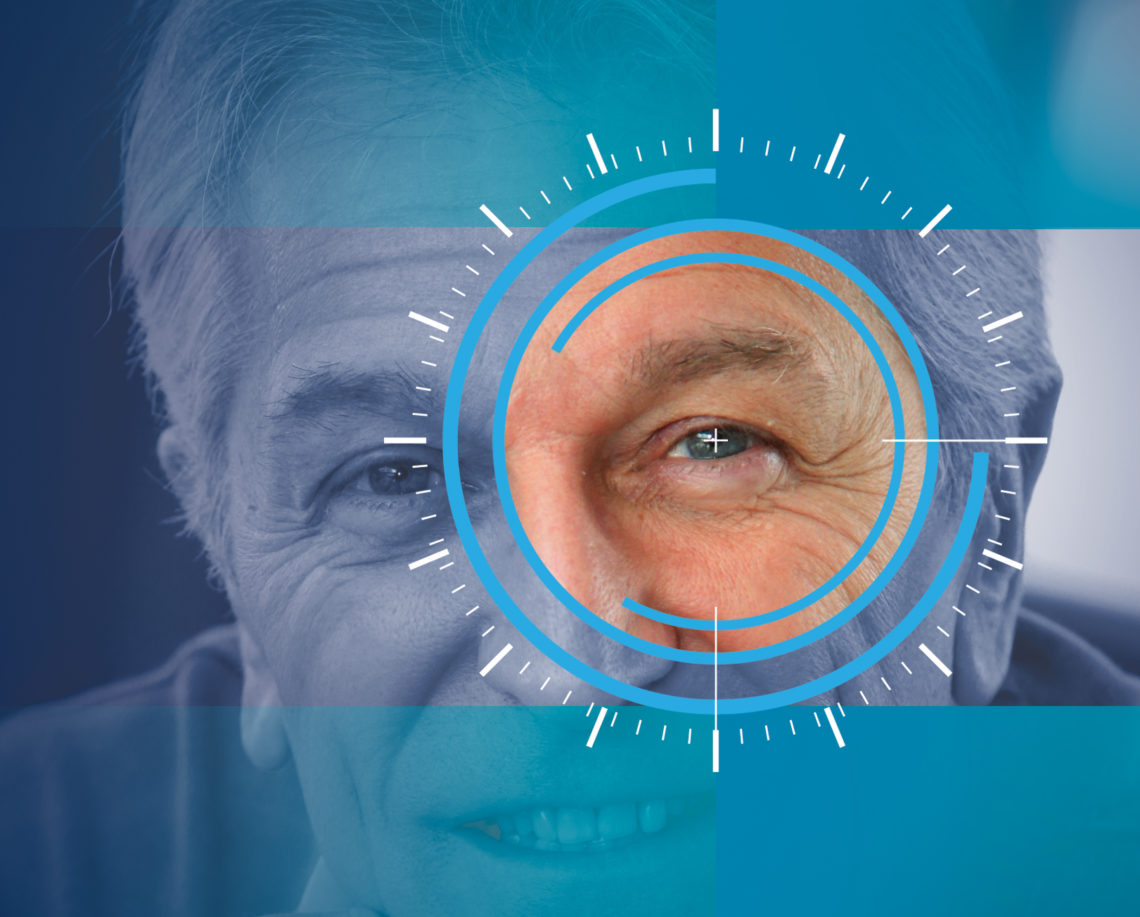Cataract Surgery
What is a cataract?
A cataract is a vision impairment resulting from a cloudiness of the lens in the eye that prevents light from being focused clearly. Cataracts typically form naturally with age, but can be caused by trauma to the eye, medications like steroids, diabetes and exposure to ultraviolet light. Cataracts usually form in both eyes, but the cataract in one eye may be more advanced than the other. Most people have some clouding of their lenses by age 60. If not properly treated with surgery, cataracts can lead to severe vision loss or blindness.
Symptoms of cataracts include:
- Cloudy vision
- Difficulty seeing at night
- Halos around lights
- Frequent changes in glasses or contacts prescriptions
- Double vision in one eye
- Poor night vision
- Light sensitivity
- Seeing faded colors/not as vibrant as they used to be
Treatment Options
Surgery is the only treatment option for cataracts. Cataract surgery is one of the most commonly performed surgical procedures in the United States. Cataract surgery significantly improves vision and quality of life for patients who undergo the procedure. Some eye diseases or medical conditions can increase the risk for complications from cataract surgery, so it is important to discuss your medical history with your ophthalmologist.
Cataract surgery is performed while you are comfortably awake in our out -patient ambulatory surgery center, where our focus is solely on surgery of the eye and its surrounding structures. During surgery, your cloudy lens is removed and an intraocular lens (IOL) is implanted and becomes a permanent part of your eye. We offer the latest advancements in lens implants and surgical procedure options to create a custom experience for every cataract patient.
Schedule an appointment
To schedule an examination to determine if it is time for you to have cataract surgery, or a cataract surgery consultation at any of our four convenient clinic locations, contact us at (803) 779-3070.
Traditional vs. Laser Cataract Surgery
During cataract surgery, the physician makes a small incision in the cornea with a handheld blade or with a laser. A small probe then breaks up your clouded natural lens into microscopic particles using high-energy sound waves and the particles are gently suctioned away. A folded replacement lens (IOL) is inserted through the incision, unfolded and positioned. The small incision is “self-sealing” and usually requires no stitches. Once removed, your cataracts will not grow back.
In a traditional cataract surgery procedure, incisions are made by your surgeon using handheld blades. Laser surgery allows the surgeon to make incisions with a laser rather than a hand-held blade. Laser cataract surgery is offered by some surgeons and may be able to offer some benefits over traditional cataract surgery depending on the specifics of your eye.
Replacement Lens (IOL) Options
There are a host of replacement lens options available. Your surgeon will recommend a lens during your consultation visit based on your individual visual needs, including your hobbies, activities, lifestyle, and pre-existing eye conditions such as glaucoma or macular degeneration. Depending on the lens you choose, even patients who have had glasses for most of their lives may be able to reduce or eliminate their dependence on glasses or contacts.
Monofocal
A monofocal lens is designed to provide clear vision at a single focal point. A monofocal lens is the basic lens included in the cost of the procedure and is covered by Medicare or insurance. With a monofocal replacement lens, you will need glasses for most activities including distance and near. However, your dependence on glasses will change and you may be free from glasses for certain activities.
RxSight Light Adjustable Lens™ (LAL®)
The RxSight Light Adjustable Lens™ (LAL®) can be customized after surgery once your eye has healed to optimize your vision based on your unique preferences and lifestyle requirements. Adjustable lenses are made of a special light-sensitive material that changes the shape and power of your implanted lens in response to non-invasive ultraviolet (UV) light to target your custom prescription. Your surgeon will work with you to achieve your best possible vision with 1–3 light treatments administered in-office, followed by two “lock-in” treatments to make your lens prescription permanent. While your vision is still in the adjustment phase, you will be asked to wear glasses that prevent UV light from altering your lens to protect it before the final lock-in.
Multifocal/Trifocal
Multifocal/trifocal advanced technology lenses are designed to provide clear vision at two or more focal points. In patients who qualify, multifocal/trifocal lenses may be able to reduce or eliminate the need for glasses for both distance and near related tasks.
Extended Depth of Focus (EDOF)
Extended depth of focus (EDOF) lenses are designed to create an elongated or extended range of vision. In patients who qualify, EDOF lenses can help reduce or eliminate the need for glasses for distance and intermediate vision.
Toric
A toric lens is the best lens to use for astigmatism correction in patients who qualify. Toric lenses have a single “mono” focal point, similar to a monofocal lens. With a TORIC lens, the objective is to reduce the burden of astigmatism in your vision. This enables more clarity and focus, with and without corrective glasses.
Medicare and Insurance
Medicare and most other insurance covers a basic procedure including traditional cataract surgery with a monofocal lens. You may also pay out-of-pocket to upgrade to laser cataract surgery with a premium lens and Medicare will cover up to the standard costs associated with a basic procedure.
What to Expect During Your Consultation
You will meet with your surgeon at one of our four convenient clinic locations for a consultation to plan your cataract surgery prior to scheduling the procedure. During your visit, your surgeon will provide information for you to decide between traditional and laser cataract surgery and recommend the best replacement lens (IOL) option for you based on your eye health, lifestyle and vision needs. Based on your choices, your surgeon will make a custom plan for your cataract surgery.
You will be given pre-operative instructions on how to prepare for your procedure as well as prescriptions for eye drops you will need to use after your surgery so you can obtain them prior to your surgery day. Please bring all medications prescribed by your cataract surgeon with you on the day of your surgery.
Edward G. Crosswell, M.D. Pre-Op Instructions
Edward G. Mintz, M.D. Pre-Op Instructions
R. Mitchell Newman, Jr., M.D. Pre-Op Instructions
Joshua Nunn, M.D. Pre-Op Instructions (DROPS)
Joshua Nunn, M.D. Pre-Op Instructions (DROPLESS)
Garner J. Wild, M.D. Pre-Op Instructions
Prior to your procedure you will be contacted to inform you of any amount not covered by Medicare or other insurance that will be due prior to your procedure.
What to Expect on Surgery Day
You will need to have someone accompany you on the day of the surgery who can drive you home. When you arrive at the surgery center, you will be checked in and offered a mild sedative to help you relax during the procedure. In preparation for your surgery, the area around your eyes will be cleaned and a sterile drape may be applied around your eye. Eye drops or a local anesthetic will be used to numb your eyes. When your eye is completely numb, an eyelid holder will be placed between your eyelids to keep you from blinking during the procedure.
Once the procedure is complete, your eye will be protected with a bandage or shield, which can typically be removed within a few hours. You will receive instructions on how to care for your eye in the days after your surgery and may receive a prescription for eye drops. You will be required to wear a protective shield while you sleep for a few days after the surgery. You should avoid bending over so as not to put additional pressure on the eye, swimming, exposing your eye to irritants, and strenuous activity for a few weeks. Do not rub your eye. Most patients return to their normal activities within a day or two.
Edward G. Crosswell, M.D. Post-Op Instructions
R. Mitchell Newman, Jr., M.D. Post-Op Instructions
Joshua Nunn, M.D. Post-Op Instructions
A follow-up appointment will be scheduled for the next day and you will go home shortly after the surgery to relax for the rest of the day.
Some patients are able to see clearly after only a few hours, but it’s not uncommon for patients to take a week or two for your vision to come into sharp focus. If you have selected a premium replacement lens (IOL) you will be able to perform most of your everyday tasks without glasses or contact lenses.
Temporary Glasses After Cataract Surgery
About a week after surgery, your distance vision will become more clear and you may need inexpensive over-the-counter reading glasses. Although they may not be perfect, temporary readers will not harm your vision and can provide good reading vision. The higher the power (in .25 increments from +1.00 to +3.50) the closer the focus. For mid-range tasks like a computer screen, a lower power will work better.
If only one eye has had cataract surgery and your old prescription lens is significantly different, it can be removed from that side of your glasses frame. The opticians in our Optical Shop can assist with removing the unneeded lens. You may also choose not to wear your old glasses and use the eye that has been operated on without glasses as much as possible. It may take your brain some time to adapt to whichever approach you choose.
You should wait about a month after surgery before having any new prescription glasses made to allow your prescription to stabilize.
Learn More About Cataracts & Cataract Surgery
American Academy of Ophthalmology
Pre/Post Operative Instructions
Download instructions from your surgeon.
Edward G. Crosswell, M.D. Pre-Op Instructions
Edward G. Crosswell, M.D. Post-Op Instructions
R. Mitchell Newman, Jr., M.D. Pre-Op Instructions
R. Mitchell Newman, Jr., M.D. Post-Op Instructions
Joshua Nunn, M.D. Pre-Op Instructions (DROPS)
Joshua Nunn, M.D. Pre-Op Instructions (DROPLESS)
Joshua Nunn, M.D. Post-Op Instructions


 ANNOUNCING UPDATES TO OUR COVID-19 SAFETY PROTOCOLS
ANNOUNCING UPDATES TO OUR COVID-19 SAFETY PROTOCOLS